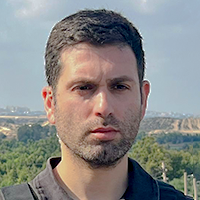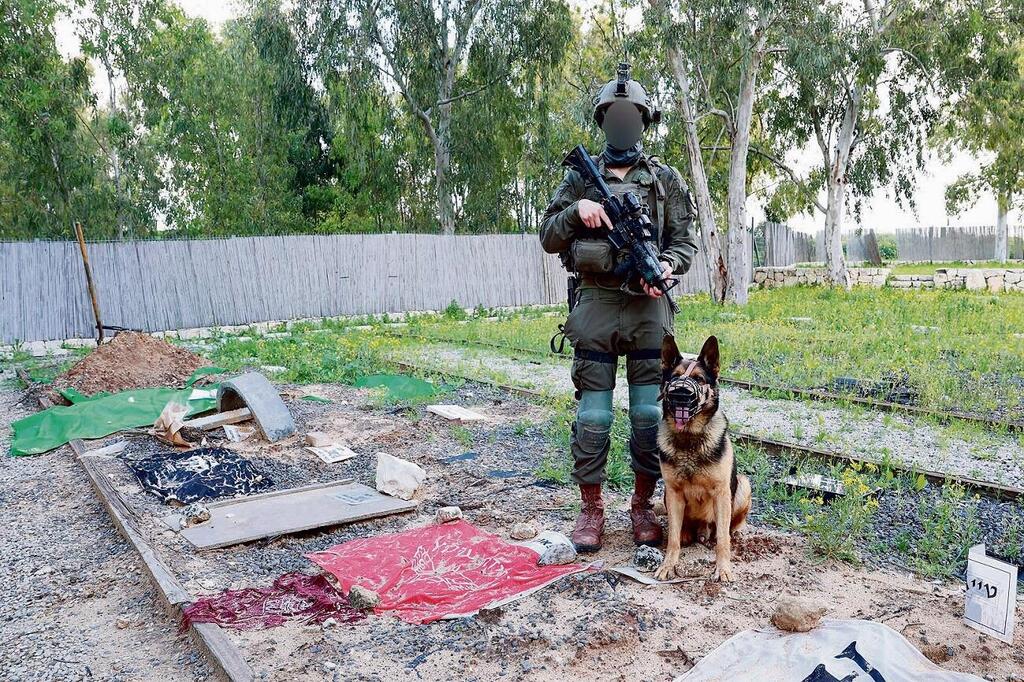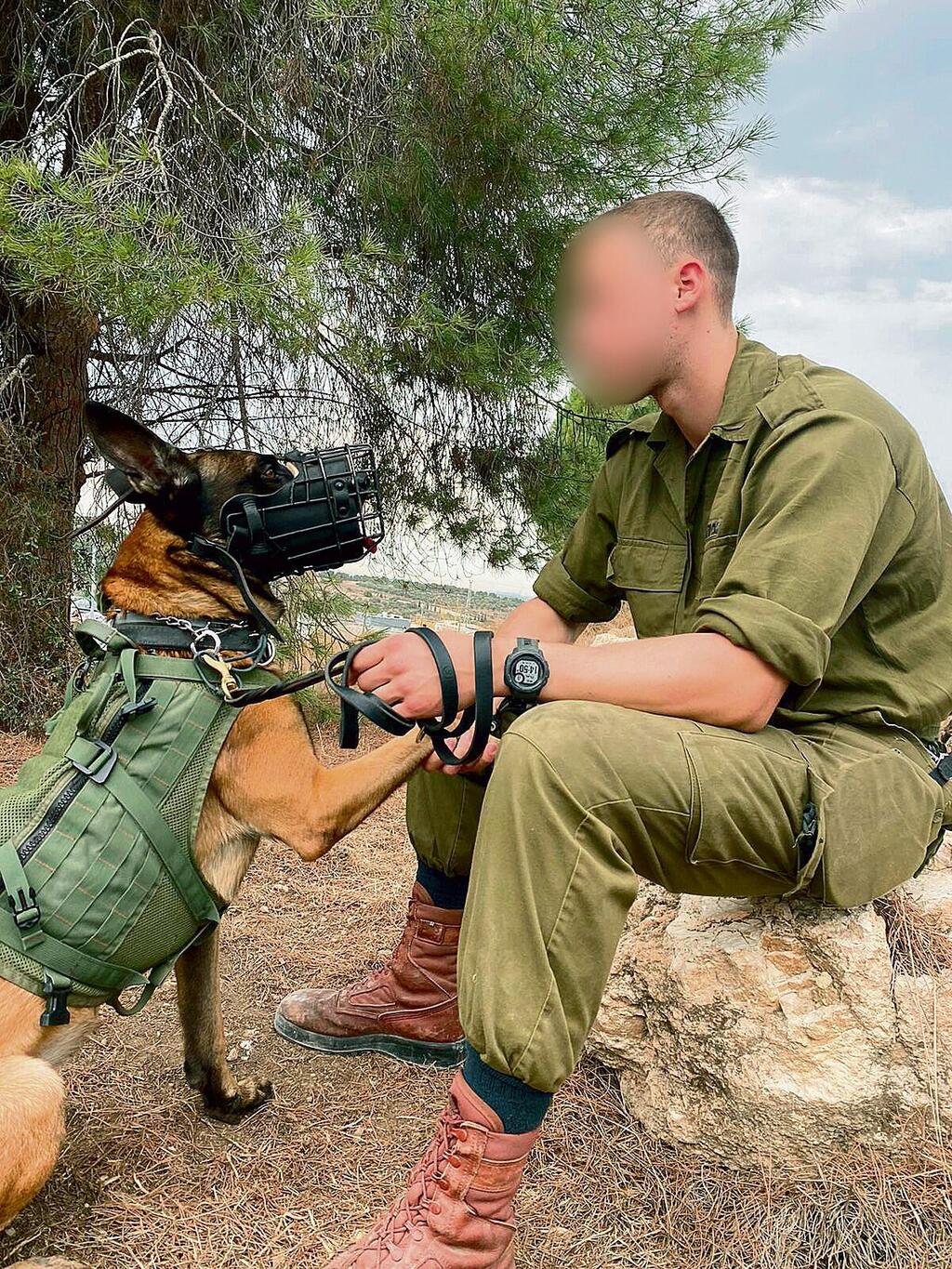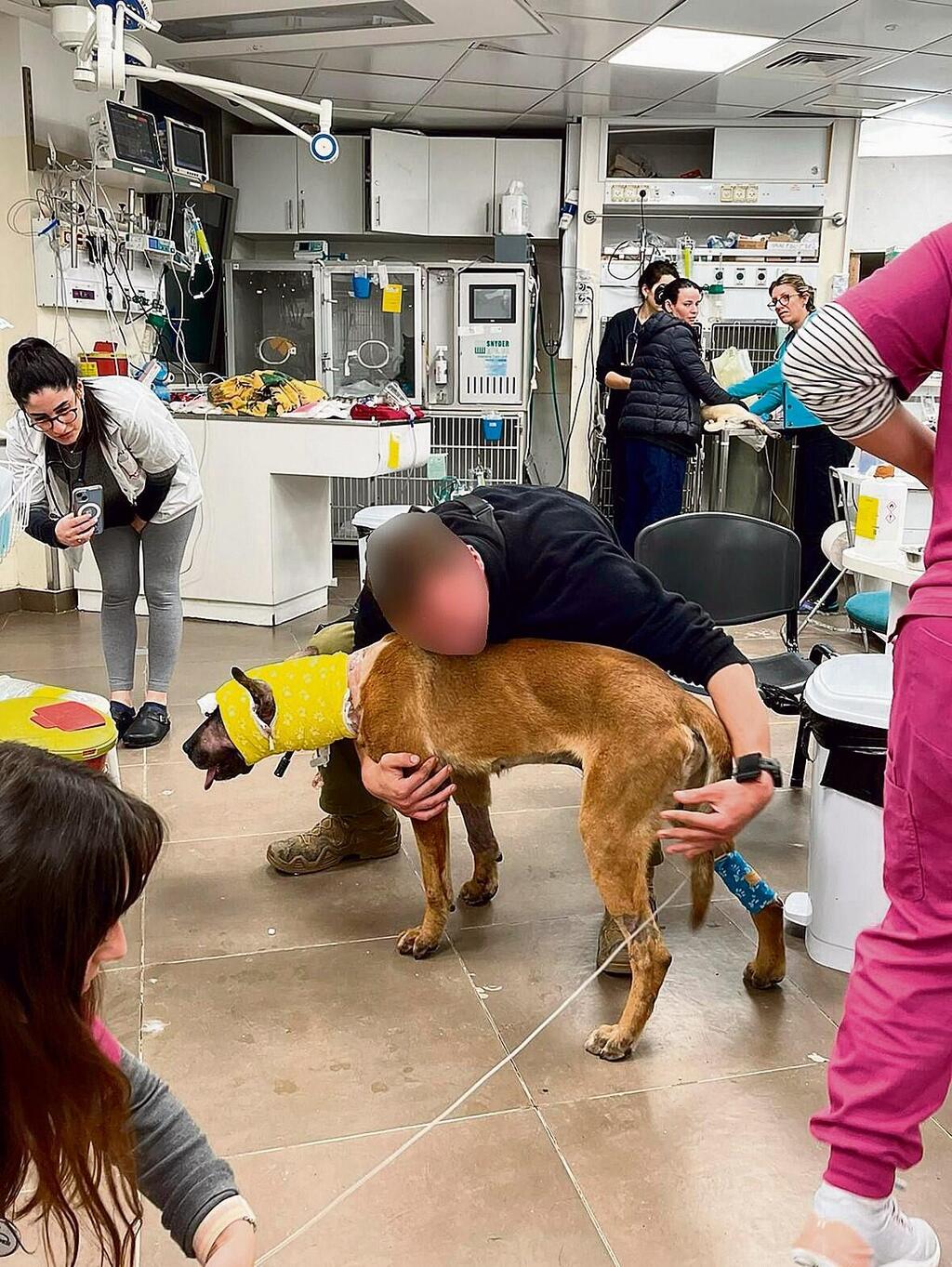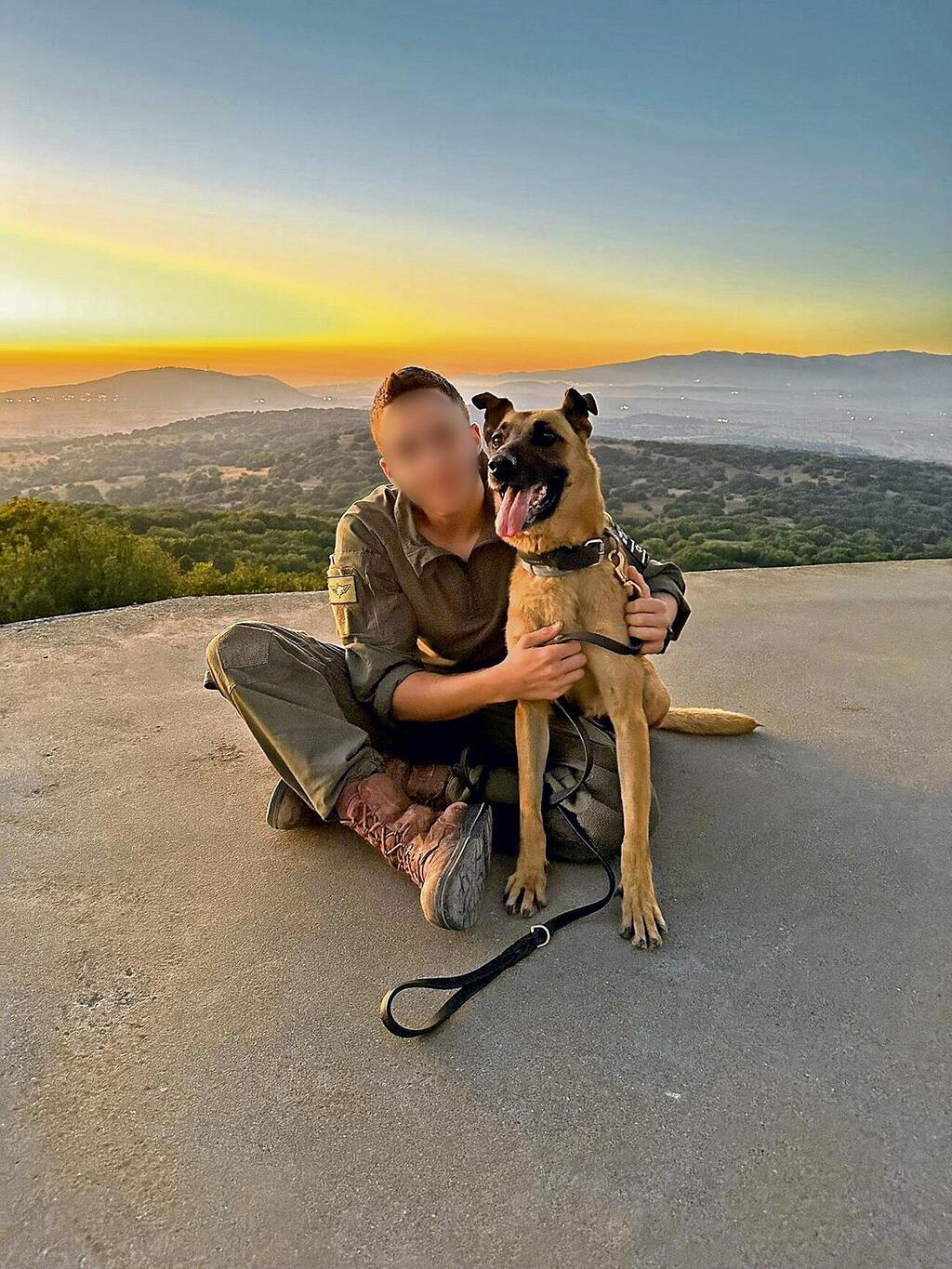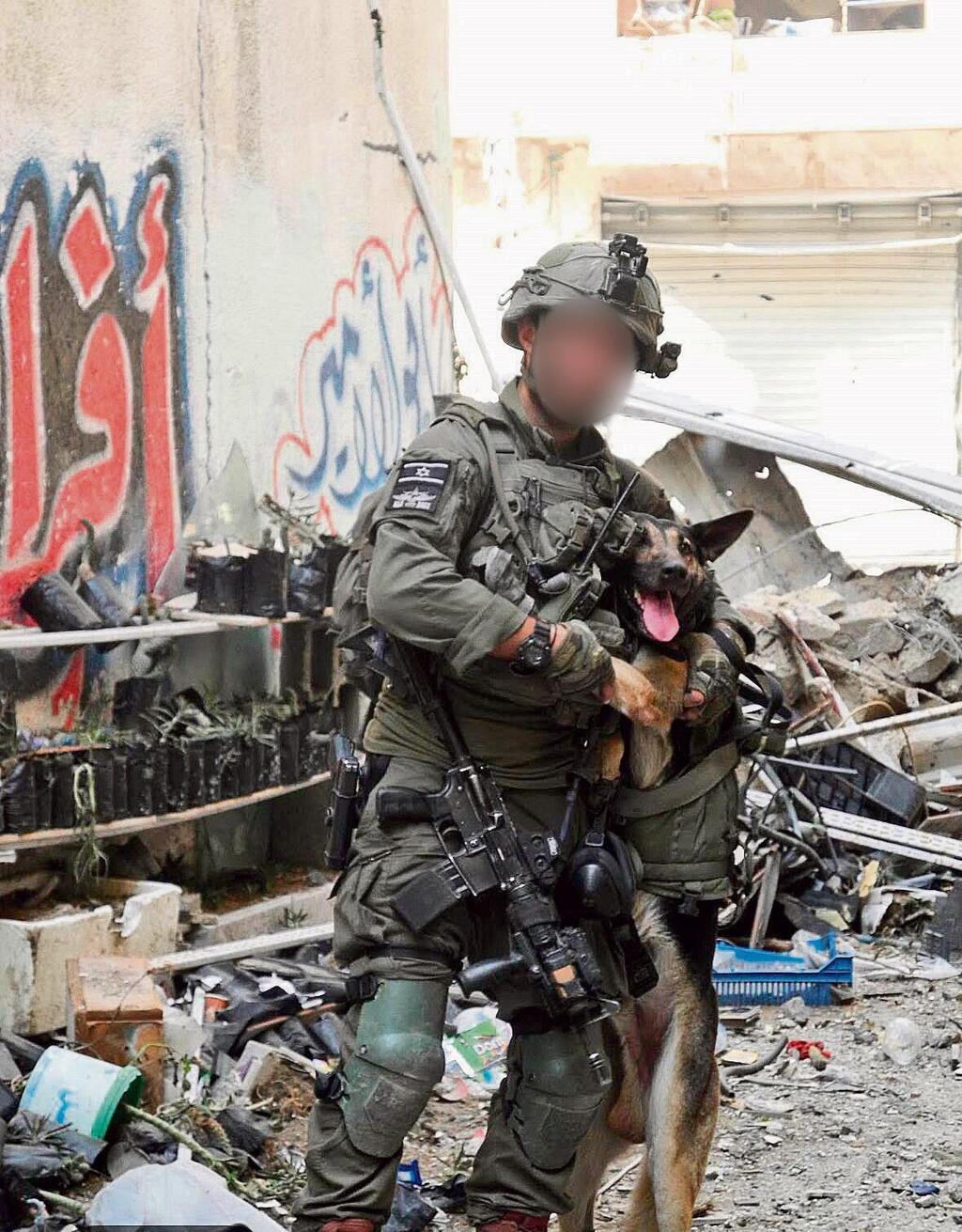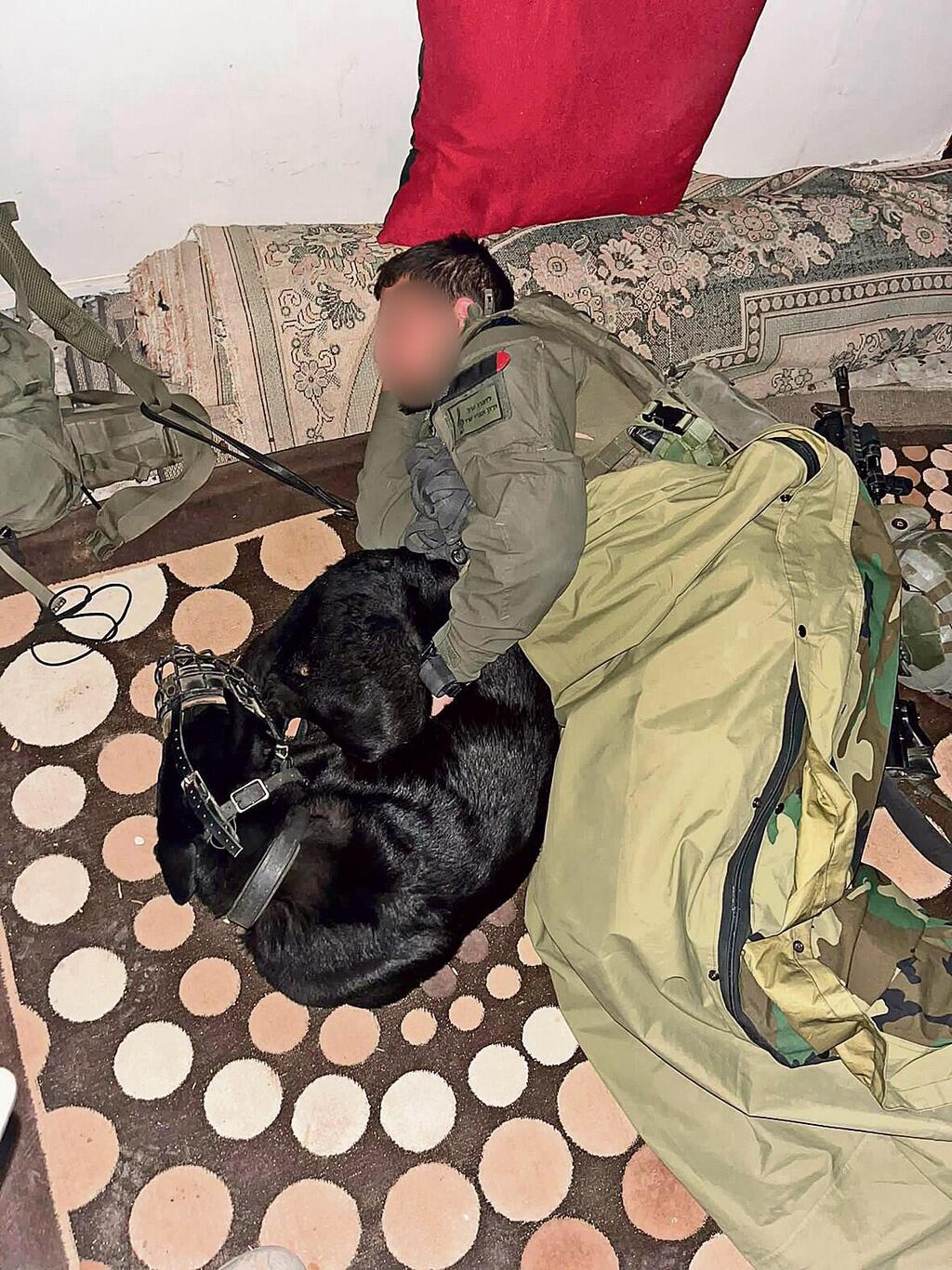Injured and bereaved handlers lost their combat dogs while fighting in Gaza, usually while their partner saved countless lives. Oketz soldiers honor their canines for the last time.
Suddenly, Jack sensed that something was wrong. It was a cold November night, on the outskirts of Jabaliyah, one of Hamas' strongholds. Nahal soldiers were waiting in ambush for the terrorists. At the head of the force was Jack, a Belgian Shepherd attack dog trained for combat, and the soldier who worked with him, a role known in the unit as the "handler." Around them was silence, complete silence, occasionally broken by distant gunfire. There was no way for the Nahal soldiers to be aware of the nightmare that was unfolding: they were exposed, and a squad of terrorists was stealthily advancing. Their ambush was about to turn into an ambush against them.
Warriors on four
But just dozens of meters before the terrorists reached them, Jack the dog identified them. He didn't bark or make a sound, he simply stopped and lay quietly on the ground. In doing so, he signaled to his handler and the other soldiers to do the same. And that's exactly what they did. "Then a hail of fire and grenade explosions began from close range," recounts an Oketz soldier. "Jack was the first, he took ten bullets and was killed."
And the soldiers?
"Thanks to his warning, the rest of the soldiers were either injured or unharmed. The terrorists were neutralized."
How to neutralize a terrorist
Jack is one of 19 dogs from the Oketz Unit that have been killed so far in the Gaza war. They saved hundreds of soldiers, found explosives, detected terrorists, and even captured them. It's highly doubtful whether any military has ever used combat dogs so extensively on the front lines anywhere in the world.
"Usually, the American army goes out with dogs for a two to three-day operation, so they were amazed that we have had dogs in enemy territory and in intense combat for four months already," explained Major N., the deputy commander of Oketz. "I don't think there's any army in the world that has operated dogs like this, for such a long time. Some of them worked almost every day in Gaza without a break."
Since the beginning of the war, most of the frontline battalions in Gaza have been accompanied by an Oketz team. Such a team usually includes two dogs, two handlers, and a team commander. One dog in the team is trained to detect explosives and charges; the other is trained to locate terrorists and apprehend them. Contrary to propaganda, the attack dogs in the IDF are not trained to kill terrorists or to catch them by the neck, but to latch on to only one of the limbs. This is usually enough to neutralize a terrorist.
Just a few days ago, an attack dog targeted a terrorist who opened fire at Commando Brigade soldiers in Khan Younis. The dog was so fast and intimidating that it pinned the terrorist down for 20 minutes with the AK-47 still in the terrorist's hand. However, Hamas learned it could use animals as well and so the terrorists began to tie up mostly female dogs to confuse the IDF dogs. Recently, Hamas has added sheep and goats. "Our dogs are trained to ignore explosions and gunfire, and even other animals," Oketz officers clarified.
There is a unique relationship between dog and handler to the extent of true camaraderie. "Once, I crawled under fire to rescue my dog," said Staff Sergeant A., an Oketz soldier. It turns out that dogs also develop these ties between themselves.
This is what happened between the dog Ivonne and the dog Charlie. In their team, Ivonne was an explosives detection dog and Charlie was the terrorist hunter. Ivonne's handler is Staff Sergeant A. and two have already saved each other countless times.
When a fire broke out in a building in the Shati refugee camp and threatened to trap them both on the third floor, Staff Sergeant A. first pushed Ivonne out of the window, saving him. Ivonne went wild in the alley and didn't calm down until A. also managed to jump out of the window and jump down, just so his dog would calm down before the terrorists arrived.
The two were saved, and Ivonne rejoined Charlie in the forefront of the unit, this time at the Shati camp. "I sent Ivonne in the middle of the night to scan the basement floor of a suspicious building, fitted him with cameras and flashlights, and inside the basement I noticed that he stopped and looked at something, but I didn't see what," A. recounts. The unit suspected that these were terrorists in ambush, so they sent Charlie to locate and capture them. "Suddenly we heard a blast and Charlie whimpering," A. said quietly.
"We threw six grenades inside, backed away, and fired a tank shell and a missile from a combat helicopter at the building. The next day we returned to the place to look for Charlie. Again, we sent Ivonne. This time, Ivonne signaled to us that there was a corpse in the rubble, apparently his friend Charlie's body. Unfortunately, we couldn't retrieve his body, and yes, it's hard and sad to see an Oketz soldier shouting to his dog 'To me! To me!' and he doesn't answer or come back. In hindsight, we understood that the terrorist looked at Ivonne and deliberately did not shoot at him, to lure us. I saw Ivonne was upset that his friend was killed. Ivonne is one of the smartest dogs in the unit, it's hard to fool him."
Charlie was added to the list of attack dogs killed in Gaza. When his body is found, it too will be buried in the unit's base: the graveyard for fallen combat dogs. We were there this week with Deputy Commander Major N. He pointed to the grave of the dog Apache, who belonged to another group of military dogs, exposed only in this war.
These dogs are trained abroad for a particularly sensitive mission. Their role is to locate bodies, including those of captured or fallen Israeli soldiers, so they can brought back to Israel. "Their level of skill is so high that they know how to stop and indicate a body part to us without desecrating or touching it," explains Major N.
"Some of them found three bodies in the disaster in which 21 reserve soldiers were killed." Apache himself was killed a few weeks ago in a sensitive operation, the details of which cannot currently be disclosed.
Dog Cemetery
Major N. and many of the other soldiers were deployed on October 7 and took part in the fighting in Gaza. Most of them simply arrived at Gaza border towns and began fighting. N., for example, fought in Be'eri, but attack dogs were also deployed and assisted in the fighting. One of the dogs, Buddy, became an icon in the unit. It happened when a squad from Sayeret Golani stormed terrorists in Be'eri, but did not identify a terrorist who had hidden inside a building and ambushed them. Buddy exposed him, but the terrorist managed to shoot three bullets into Buddy's chest.
"His handler fought for him in the field and insisted that they treat him, even though at that time the order was to treat only the Israeli wounded," recalls Major N. "The dog was bleeding profusely, the handler applied a tourniquet, gave him fluids, and his life was saved. For a handler, the dog is like an organ in his body."
What is Buddy's condition today?
"Buddy is still in recovery and has undergone complex surgeries."
Aside from Buddy, four combat dogs were seriously injured during the war. The unit also paid a heavy human price: the Assault Platoon Commander, Major Aryeh Ziering, fell on October 7, and 42 additional soldiers were injured, most of whom returned to service. Injured and recovering dogs are transferred to a special post-trauma veterinary hospital before returning to the battlefield.
Every combat dog "enlists" when they are a year old. Most will serve two to three terms with two to three handlers until they reach the age of ten when they retire. The last handler gets the privilege of taking the retired dog home, and many do. However, not all attack dogs retire. In total, the unit lost 173 dogs during its years of operation.
Despite the obstacles, dangers, and pressures, they continued to persevere, demonstrating without fail the essence of camaraderie and dedication
Some were not buried in the cemetery, either because they were not located or because they were killed in covert operations, beyond enemy lines, and their handlers had to leave them behind. Some of the 19 dogs killed in Gaza are still waiting for burial in refrigerators because their handlers were injured or are recovering - and they refuse to bury their beloved dog without them.
At the entrance to the dog cemetery in the unit, there is a statue of a handler with an attack dog, along with a plaque on which a secular prayer called "The Dog's Prayer" is inscribed, ending with the words: "Despite the obstacles, dangers, and pressures, they continued to persevere, demonstrating without fail the essence of camaraderie and dedication." Some of the fresh graves still have flower wreaths; on Apache's grave, someone took care to place a piece of concrete from the building where he found his death.
This week we visited the base to hear the stories of four of these heroes who fell in Gaza.
Rico
Handler: Sergeant N. from Tel Aviv, aged 20
Dog: Rico, a four-year-old Belgian shepherd, trained for pursuit and attacking
Jabaliyah Camp, January 16, 2024. N. and Rico joined Battalion 932 of the Nahal Brigade. The unit was clearing a building when an armed terrorist emerged and opened fire on the soldiers. The terrorist positioned himself advantageously, protected by the building, in a corner that prevented the soldiers from targeting him. The exchanges of fire were prolonged, "and then we closed in on the house where the terrorist had escaped to," N. said.
"We sent a scanning drone there, which found two more terrorists in the building and a tunnel exit. After heavy fire on the building, we sent the drone again, which saw the dead terrorists inside. And then I sent Rico to make sure there were no more terrorists inside.
"Suddenly I saw Rico already on the second floor, attacking the bodies of the terrorists and shaking them and then there was a huge explosion. I called to him 'Rico, to me!' but he didn't come back."
What goes through your mind at a moment like this?
"A lot of thoughts passed through my head. I felt alone, within myself, and that he won't come back anymore. It was a moment of silence, everyone looked at me and couldn't find the words to comfort me. There's a contradiction here: on one hand, the soldiers beside me owe their lives to him, and on the other hand, he's no longer with me. We've been through a lot together in the past six months, and I was so proud of him, because the platoon commander who was me was a step away from the second floor, and his life was also saved thanks to Rico."
What did you do afterward?
"We left the building and requested to bomb it with two bombs from a combat aircraft. I knew Rico was already dead. Our assumption was that he was killed by an explosive device placed there or by a grenade that a terrorist pulled out of his belt and left with a closed pin under his friend's body before being killed himself, so if the body is moved, the grenade explodes."
Is this your first dog?
"Yes, and I connected with him emotionally very much. He was the happiest dog in the world, really ecstatic when touched, just wanting attention and petting. After every mission, he would smile at me, and I at him. Rico believed that when we were working, we work, and when resting, we totally relax. No one in Battalion 932 would go on a patrol or mission without Rico. When I put combat gear on him, he would become serious suddenly, and without combat gear, Rico would be playful again. When he was with the soldiers, they were excited, and it's rare because most attack dogs don't allow others to pet them. It all hit me in one moment. With his death, he prevented the dreadful knock on the door of soldiers' parents. The commander offered to send a force to collect his body, but I wasn't willing to risk a soldier's life just to bury him."
N. went on a short recuperation vacation after losing Rico, and when he returned, he received a new older and less well-mannered attack dog than Rico, Limbo. Limbo is a seven-year-old Belgian shepherd, who earned a reputation with his combat achievements. But even with Limbo, there was drama.
N.: "I trained with Limbo for three weeks until I returned to Gaza with him. This time we were assigned to the Commando Unit, which operated in the refugee camp in Khan Younis. About a month ago, the unit was fired at from a building, and we retaliated with artillery and gunfire. Two days later, we entered to conquer it, and of course, we sent the dog first. Limbo went through all the floors, reached the fourth floor - and identified a terrorist hiding there. Limbo jumped on him fiercely, being a big and strong dog, and didn't give up. This time the terrorist started stabbing him with a knife in his face for five minutes. Limbo bled badly but didn't release his strong bite from the terrorist's body. Then the terrorist started hitting him in the head with a hammer, which made him lose consciousness. But that allowed us to shoot the terrorist from outside."
Wow. And then?
"For an hour and a half, I called him to come, and he didn't answer or come. After three hours of heavy fire on the building, we entered. I waited for them to tell me they found him dead, but the first few soldiers told me on the radio that Limbo was barely breathing. We rescued him to one of the rooms, and the unit's medics treated him with all their medical equipment, opened a small operating room for him. We bandaged him, gave him life-saving procedures, we called a specially equipped helicopter to transfer him to the veterinary hospital in Beit Dagan, but it was difficult with him, so we stabilized him until we transferred him to an ambulance at the border. Since then, three weeks of difficult surgeries have passed, but believe it or not: Limbo is back on his feet, recovered miraculously, and close to me."
And what do the veterinarians say?
"The main veterinarian here is optimistic about his chances of returning to combat because he already wants to return to Gaza. The unit's chief dog trainer told me that he has never encountered such a case. Limbo is truly a living legend. Sometimes plays hard to get, but most of the time, he's really cute, a true lion who refuses to die."
Cheetah
Handlers: Sergeant First Class A. from Kfar Hess, 25, and Staff Sergeant N., who was injured and hospitalized.
Dog: Cheetah, an eight-year-old female Belgian shepherd who was an explosives detection dog.
That cursed street in Khan Younis was full of terrorists. The paratroopers, who were joined by both handlers with Cheetah, had already reached the last building that hadn't been cleared yet. It happened on 24.1.2024. "We sent Cheetah to scan the building," recalled A., "15 seconds later, she activated a large explosive device, and was killed on the spot from the blast wave and shrapnel. The amount of explosives there was so huge that the walls of the first floor collapsed on us. N. and I were injured, but thanks to Cheetah, our lives were spared, and also the lives of another 20 soldiers, for sure.
Just two days earlier, we celebrated her birthday in the field. She had 19 successful markings of explosives throughout the war, such a device can kill or wound dozens of soldiers adjacent to it. Throughout her achievements in the war, Cheetah prevented bad news for hundreds of families. We were very sad, but it was inevitable because the dog does not always succeed in marking the explosive and sometimes it steps on a hidden detonation wire."
Hard blow.
"Yes, a stranger won't understand this, but her loss was truly a blow. We experienced difficult and joyful moments with her, experiences we will always cherish. I worked with her a lot and trained her incessantly before the war, I bonded with her emotionally in a strong way. On the night before the event, I woke up at four in the morning for the bathroom, and I saw that Cheetah was lying next to N., her head on him, patiently waiting for him to wake up, making sure no one disturbed him while sleeping. We dragged her food with us throughout the war and brought her carrots which she loved, and other things to nibble on, which I prefer not to mention because they were unknown in the unit.
"After we were injured, the paratrooper combat doctor treated us amazingly on-site, but we immediately understood that Cheetah was killed. The next day, the soldiers came to retrieve her body, and now we are waiting for N. to be ready mentally and physically, and then we will bury her at the right time. These dogs mean everything to us; they guard us and give us confidence in the battlefield, they sleep with us in Gaza, and it's not an easy struggle."
Why is she called the unit's "explosives champion"?
"Because Cheetah sniffed dozens of structures a day, at an amazing pace, giving thousands of soldiers a sense of security to enter the structures. She had a calm and friendly nature, easy to work with, and was a true princess and super professional. It was important for her to please me and N., and she sometimes worked for 13 hours straight. She was insanely committed, participated in operations in the north and also in special operations she was specially selected for, operations she excelled in."
Ziggy
Handler: Staff Sergeant N. from Tzur Yigal
Dog: Ziggy, a four-year-old Belgian shepherd trained for detecting explosives
Everything happened right before N.'s eyes, from point-blank range, and perhaps this is the most difficult situation for a handler: when your dog is killed in front of you.
On the first day of 2024, the paratrooper's Battalion 101 operated in Khan Younis. The unit located a structure whose entrance was rigged with explosives. The engineering corps neutralized the explosives, and the unit prepared to enter. First, Ziggy was sent into the building. Almost immediately, he stood in front of a storage cell under a flight of stairs, where he discovered three armed terrorists hiding, waiting for the soldiers. It was a matter of seconds: the terrorists fired a storm of bullets at Ziggy and then the battle began.
"Ziggy was killed instantly, and this is the toughest situation for a handler. He was killed right in front of me, and quickly I understood that there was no way to save him, and that first, we needed to eliminate the terrorists," N. recounted. "There was a lot of chaos, the battle lasted half an hour inside the house, while I was bleeding until they evacuated me without him. Ziggy was thrown about by the terrorists' explosion."
Seven of the soldiers there were lightly to moderately injured, including N. There is no doubt that Ziggy saved their lives. "The soldiers extracted Ziggy's body and I still haven't buried him," he said. "It will happen only after I recover. Ziggy taught me a lot about patience and the importance of our basics, and he deserves this honor."
This was certainly not the first time Ziggy identified danger.
"Not at all. He participated in many operations in the north and in the West Bank, even before entering Gaza. He identified an explosive device on the security fence in Gaza before the war, and marked two explosive devices during the incursion."
N. is now in rehabilitation.
"I am supposed to begin my officers' course after I finish rehabilitation, and as an officer in the unit, I won't be partnered with a dog, so I already miss him and the difficulty without him is great, but alongside that, he really saved my life and the lives of the paratroopers. We had many small and happy moments together, Ziggy slept with me in Gaza and woke me up with his wet nose and cold touch on my face. He had the character of a little child with a baby's face, he did a lot of mischief and jokes, but at the moment of truth, he understood the job and knew what was expected of him, so I relied on him with great confidence. With time, he became the pride of the unit, everyone played with him in the Gaza Strip, asking about his well-being. In the most critical moments, I would look to my left and gather strength from the best partner I could ask for in combat."
Loco and Lennon
Handler: Captain (res.) A., squad commander in Oketz, 28, from Jerusalem
Dogs: Loco, seven years old, and Lennon, five years old, both Belgian shepherds trained as explosive detection dogs
For an Oketz soldier, losing a dog is one of the most terrible things imaginable, to lose two is an absolute nightmare. Especially when it happens within six hours.
That's what happened to A. At the beginning of the ground incursion, Captain A. was attached with his dog, Loco, to a force that stormed into Jabaliyah and the Tuffah neighborhood. "We captured a clinic that Hamas took over," he recalled. "Combat engineers spotted a large explosion about 40 meters from us on the street, near a force ahead of us. On instinct, we ran forward, but then we stopped because I realized we were actually entering a minefield. Simultaneously, an explosive charge was thrown at us from above."
"We returned fire, and for about half an hour, we fought from a nearby alley until the house was completely silent. The platoon commander in the area decided we should enter the building and we prepared to break into it, but I told him it's better to wait, and first breach the wall with the engineering devices, and then enter, also to avoid sending Loco to his doom. And so it was. But ten seconds after I sent the dog inside, I heard a blast and the dog's whimpering," he said.
What happened there?
"A terrorist who hid under the stairs shot in his direction and killed him on the spot. The battalion commander in the area decided we would attack the building and fire more tank shells. I took advantage of this time to call another Oketz handler, who had Lennon. We sent Lennon to scan the area and he found an anti-tank missile. We started to scan the building again, and we realized that this terrorist inside the building was not an amateur: he disassembled the equipment from Loco's body. We identified the traces of the terrorist who went up a floor, so we sent Lennon in his direction. And then again I heard a blast and grenades thrown at us on the lower floor."
That's terrible. What did you do?
"First of all, I immediately grabbed the soldier next to him and threw him back, so that he wouldn't get hurt. I realized that the terrorist who went up was hiding in a spot that was difficult to identify, and Lenon went up, found him but was killed by the terrorist's fire."
How do you continue?
"I continued to fight with tears in my eyes, and the truth? I also saw the soldiers from the Nahal Brigade crying. Without Lennon, this terrorist would not have been found like this. We recovered the bodies of the two dogs and that night, after midnight, we buried them in a ceremony in the unit and I paid tribute to both of them. Before I left Gaza for the funeral, the company commander from Nahal gave me a big hug and told me that thanks to Lennon his life was saved."
Were Loco and Lenon similar in character?
"Completely different. Lennon was a big, beautiful and noble dog with smooth, brown fur, who constantly wanted to get attention. A week and a half before he died, he was slightly injured, and managed to undergo field surgery with four stitches. Loco, on the other hand, was an attack dog, but gentle, really small, always messing around, and I would call him an attack rat at first. No one believed he was an attack dog but once I sent him to attack a terrorist, my God, what a high work ethic he had."
"We worked with them day and night, invested a lot in their professionalism and emotional connection, and every time we sent them on a mission, we felt that it might be the last time. It leaves a bittersweet taste, because in their deaths the lives of dozens of soldiers were saved. What's more, they both loved beef jerky. And the truth? The most moving moment was seeing a soldier, no matter how hungry he was, sharing food with them, half for himself and half for Loco or Lennon."



